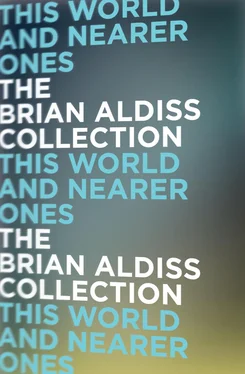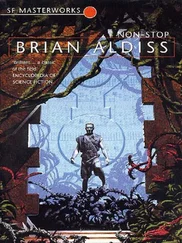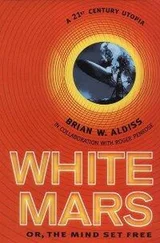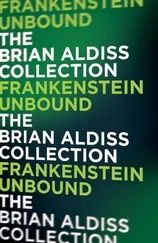Despite the slaughters, the findings brought back by British and French three-masters stimulated a debate on the nature of man and his place in the universe which still continues. The slow, creaking three-masters have been replaced by speedy surrealist kitchen utensils cutting up the sky. The findings of Mariner spacecraft, with their startling crop of pictures, the harvest from Pioneers, Vikings and Voyagers, give impetus to the quest for extraterrestrial life. But our modern findings are undoubtedly less corporeal: eighteenth-century sailors copulated on warm sands with the dusky ladies of the South Seas in exchange for nails. The rewards of technology were never better or more immediately demonstrated.
The more efficiently the early engines could be seen to work, the faster they multiplied. The faster they multiplied, the more dominant they became. It was like a re-run of the story of prehistoric reptiles. Samuel Butler observed this phenomenon clearly and, in Erewhon (1872), gives one of his scribes this ominous sentence: ‘The present machines are to the future as the early Saurians are to man.’ The argument goes on, ‘I would repeat that I fear none of the existing machines; what I fear is the extraordinary rapidity with which they are becoming something very different to what they are at present.’
Butler’s fear was not a particularly common one, judging by the success of technology. When Cook was killed in 1779, Britain was rapidly becoming covered with a network of canals – the first modern transport system, the biggest thing since Roman roads. Soon no major city lay farther than fifteen miles from a busy water link. In another generation, the new roads had arrived; 1600 Road Acts went through Parliament between 1751 and 1790. On new roads, new light coaches – a new thing; all classes could afford to travel. And in a further generation, at the moment when coaching had reached its zenith of speed and organisation, in came the men from the North with their railways, and swept into darkness with a vast exhalation of coal smoke, the slow moving past.
When the painter J. M. W. Turner, born as the American War of Independence began, died in 1851, the Western world had undergone one of its greatest periods of transition – and was undergoing another.
New landscapes required new perceptions. The interpretation by trained artists of those exotic panoramas first sighted over the taffrail of the Endeavour or the Bounty led to the overthrow of a classical generalised style of art in favour of the art of the closely studied and the particular. This is what Ruskin means when he says in Modern Painters , apropos of Turner, that, ‘For the better comfort of the non-imaginative painter, be it observed, that it is not possible to find a landscape, which if painted precisely as it is, will not make an impressive picture.’ So Zoffany and Reynolds give place to Constable and Ward, and early Turner to late.
The earthworks thrown up all over England to accommodate the railway line left their mark in the minds of men. When Brunel built his Great Western Railway from Paddington to Bristol, the comparative feebleness of his steam-power meant that the track had to run level to within 1/12,000th of an inch for the whole hundred-mile journey. One can see Brunel’s cuttings still, guarding the line up the Thames valley to Oxford. There lie the chalk strata, put down millions of years ago by minute creatures, brought back to the grimy light of day a century ago by sturdy Victorian navvies.
A cardinal perception dawned: that the rocks of old Earth, or the coral islands of the new oceans, were petrified Time. It was almost but not quite what Burnet meant when he said: ‘We have still the broken materials of that first world, and walk upon its ruins.’ Embalmed in gritty streets lay secrets of past history just as urgent as a journey from Birmingham to Liverpool. Understanding lent a window on epochs long past and on times to come.
Geology was in many ways the giant, the Prometheus, of nineteenth-century science, bursting open the other doors of the cultural gallery. It is a curious linkage of the physical and the metaphysical to think of the poor stonemason, Hugh Miller, chopping away in the dust of the red sandstones of Scotland, and thereby helping to sketch that teeming pageant of organic life we now accept without blinking: that pageant which belongs with amino acids in a nameless ocean, and the first single-celled creatures, and which swells in grandeur and colour and possibly hideousness through the ages of amphibians and rampant trees and great dinosaurs that walked like men, on to the dodo and to Us, going about our archaic rituals. That pageant is among the most permanent to emerge from the permanent ways of the Railway Age.
Almost all that we can learn or imagine is inherited, the produce of the labours of others. So it always was. Aided by the work of Miller, and of Lyell and James Hutton and Wallace and others, Charles Darwin pieced together the jigsaw of facts which form evolutionary theory. Darwin’s researches took him many years; they began when Captain Fitzroy, a godfearing sailor, had the misfortune to take Darwin aboard the Beagle .
The voyage of the Beagle was almost as momentous as that of the Endeavour ; its findings concluded part of the debate opened up by Cook. No longer ‘in doubt to deem himself a God or Beast’, man now saw himself ranged with the animals rather than the angels. Theology was never to be as popular again; but zoology won many adherents.
The early geologists learnt to distinguish between rocks of a sedimentary character and rocks formed by what Darwin calls plutonian processes. One wonders how far this dramatic inorganic model of rock-formation influenced that other great iconoclast of last century’s thought, Sigmund Freud, when formulating his theories of conscious and unconscious, from which latter well up the raw lavas of the personality’s core.
Whilst new cosmologies were discovered in the heavens – the first star photographs were taken in the 1850s – the earth yielded immense troves of dinosaur bones, notably in North America, like strange stations on the route of the railroad. Students of both Earth and sky helped roll back the carpet of the globe’s prehistory. The consequent development of scientific understanding, which takes in first one discipline and then another, creating channels of fresh thought like a flood inundating a parched land, has structured our mental frontiers; we abandon its watchtowers for superstitious faiths at our peril. Yet ours is an age easily tempted towards the mysticism of drugs and the bending of spoons by telepathy – not least because last century’s advances opened the doors of lunatic asylums as the complex nature of human mentality was unlocked, leaving us heir to a lessened fear of madness.
Whichever way we go, we see strange panoramas. As far as we can know, our vision is unique in the universe. And mankind is at present only at the beginning of its corporate lifetime.
Decade by decade, more time was needed in which to contain scientific findings related to the age of the Earth, and to cosmology. The good Bishop Ussher’s estimate that God created the world one morning in 4004 BC was laughable by Lyell’s time – the iguanodon upset that tea party. Just as men looked back to a truer perspective, other findings encouraged them to look forward. That was a new thing, too.
Not all that was new was of a sort to induce optimism. Though evolution could be made to stand as a justification for ruthless economic oppression or empire-building, it does not, on a proper evaluation, encourage any permanent feeling of security. The same might be said of Lord Kelvin’s reformulation of the second Law of Thermodynamics, which carried with it intimations of the heat death of the universe. Utilitarianism was a bleak enough creed for men; how much worse to find it written in the stars themselves.
Читать дальше










